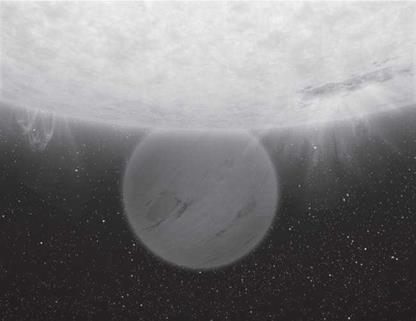Diagnosing Distant Worlds
The discovery of planets orbiting stars other than the Sun was one of the most dramatic events of twentieth-century science. Until 1995, our Solar System was unique. Since then an accelerating pace of discovery has confirmed more than 850 exoplanets, with 2,700 more good candidates.52 Many of these are Jupiter-mass planets, orbiting Sun-like stars within one hundred light-years.53 But exoplanet detection limits are steadily approaching Earth-mass, and systems with as many as seven planets, have been discovered. The majority of these exoplanets were discovered by an indirect method, where the orbiting planet induces a “reflex motion” or a wobble in the parent star, and the wobble is detected by a periodic Doppler shift in the spectrum of the star. Some of the early discoveries were “hot Jupiters,” or large planets on close orbits around their parent stars. But the Doppler detection method reveals nothing more than a planet’s mass and orbital distance.
Spitzer, by contrast, can observe exoplanets as they pass in front of or behind their star. This is an eclipse or a transit. Only the small fraction of systems where the orbital plane is lined up with our sight line can show eclipses. The detectors can gather infrared light from large exoplanets that orbit close to their star and that are heated to at least 1000 Kelvin, if the star is within two hundred light-years of our Sun. As a planet traverses the face of its star it blocks some of the starlight. There’s a temporary dip in the infrared signal of the combined system due to the planet blocking a portion of the stellar disk. This eclipse allows the size of the planet to be measured. Then when the planet passes behind the star (this is called a secondary eclipse), the infrared signal again dips because the planet’s contribution is missing from the system’s heat signal. The size of the drop is the amount of infrared emission coming from the planet. Spitzer’s extended orbit allows continuous observations over an entire exoplanet orbit, and the telescope’s ability to measure small changes of just 0.1 percent in brightness makes these observations possible (figure 9.5).
NASA’s Kepler spacecraft, launched in March 2009, is also looking for transits caused by exoplanets by staring at a region in the Cygnus constellation. Kepler scientists want to determine whether Earth-like planets, small rocky worlds with long period orbits, are common. The exoplanet Kepler 22b, which is 2.4 times larger than Earth, was the first planet found by the telescope to orbit in the habitable zone of its sun-like star. As with the Milky Way Project that uses data from Spitzer’s GLIMPSE survey, Zooni – verse’s Planet Hunters Project invites volunteers to assist NASA in digging through Kepler’s data. Kepler sends data on more than 150,000 stars to Earth at regular intervals, and volunteers for Planet Hunters survey the stars’ light-curves to identify possible transits. “Planet Hunters is an online experiment that taps into the power of human pattern recognition,” organizers explain on the
|
Figure 9.5. A distant exoplanet is partially eclipsed by its parent star in this artist’s impression. Spitzer uses observations like this to “taste” the atmosphere of an exoplanet by seeing which atoms or molecules are absorbed by the atmosphere. This particular planet is about 1000°F and the atmosphere has substantial amounts of carbon monoxide but surprisingly little methane (NASA/SSC/ Joseph Harrington). |
website. So far, two likely planets have been detected by citizen scientists in the Kepler data.54 As has been the history of science from its earliest days, nonspecialists are making serious contributions to Kepler’s scientific outcomes.
While Kepler can predict statistically the ubiquity of planets in our galaxy, it takes the sensitive instruments of an infrared telescope to characterize their composition. Spitzer’s ability to diagnose the atmospheric composition of remote exoplanets was a big surprise. Observations have been made on more than two dozen exoplanets, with dozens more expected during the ongoing “warm” mission. Spitzer project scientist Michael Werner explains the telescope’s contribution to this effort: “Because hot Jupiters are rich in gas, different wavelengths arise from different levels in the atmosphere of different chemical constituents. Spitzer data have allowed the determination of planetary temperatures and of constraints on chemical composition (including the identification of water vapor), atmospheric structure and atmospheric dynamics.”55 Though Spitzer’s primary mission was to detect objects hidden by interstellar dust, characterizing exoplanets may become its greatest contribution.
In 2007, scientists first measured weather on a planet beyond the Solar System.56 The planet HD 189733b races around its parent star in just over two days. Temperatures across the planet range from 970 K to 1220 K, which means winds of 6,000 mph must rage to keep the temperature variation that modest. By comparison, the Earth’s jet stream sails along at only 200 mph. The exoplanet Upsilon Andromeda b is even more extreme; day to night temperature variations are 1400°C, that’s 2550°F, and a hundred times larger than is typical on Earth!57 In the young, dynamic field of exoplanets, there have been many surprises, and theorists’ expectations are often confounded. One hot Jupiter-like planet was found to have carbon monoxide but almost no methane. This violates models of hot gas giants, where most of the carbon should be in the form of methane. Another two planets are shrouded by dry, dusty clouds unlike anything seen in our Solar System. These planets show little of the expected water or steam, meaning that, if present, water might be hidden under the clouds in the form of a scalding ocean.











